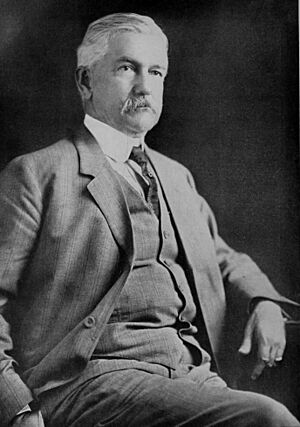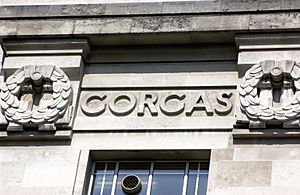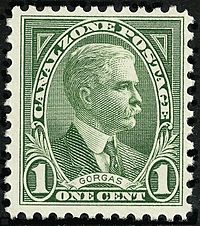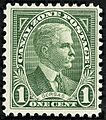William C. Gorgas facts for kids
Quick facts for kids
William Crawford Gorgas
|
|
|---|---|
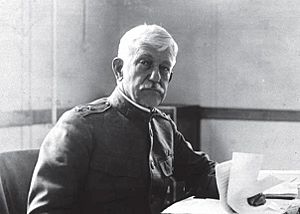
Gorgas during World War I
|
|
| Born | October 3, 1854 Toulminville, Alabama, US |
| Died | July 3, 1920 (aged 65) London, England |
| Place of burial | |
| Allegiance | United States of America |
| Service/ |
|
| Years of service | 1880–1918 |
| Rank | |
| Commands held | Surgeon General of the US Army |
| Awards | Distinguished Service Medal Public Welfare Medal (1914) |
| Relations | Josiah Gorgas (father) Amelia Gayle Gorgas (mother) John Gayle (grandfather) |
William Crawford Gorgas was a United States Army doctor. He served as the 22nd Surgeon General of the U.S. Army from 1914 to 1918.
Gorgas is famous for his important work in Florida, Havana, and at the Panama Canal. He helped stop the spread of yellow fever and malaria. He did this by controlling the mosquitoes that carry these diseases.
At first, many people doubted his ideas. But his methods saved thousands of lives. They also helped make the building of the Panama Canal possible. Gorgas also believed in a special economic idea called 'Single Tax'. He thought it would help create healthier living conditions, especially for poor people.
Contents
Early Life and Education
William Crawford Gorgas was born in Toulminville, Alabama, on October 3, 1854. He was the first of six children. His parents were Josiah Gorgas and Amelia Gayle Gorgas.
He studied at The University of the South. Later, he attended Bellevue Hospital Medical College. In June 1880, Dr. Gorgas joined the US Army Medical Corps.
Military Career and Fighting Disease
Gorgas was sent to three army posts in Texas. While at Fort Brown (1882–84), he got yellow fever himself. He met Marie Cook Doughty there, who also got sick. They both recovered and soon got married.
In 1898, after the Spanish–American War, Gorgas became the Chief Sanitary Officer in Havana, Cuba. His job was to get rid of yellow fever and malaria. He used the research of other doctors, like Major Walter Reed and Cuban doctor Carlos Finlay. They had shown that mosquitoes spread yellow fever.
Gorgas started draining ponds where mosquitoes bred. He also kept yellow fever patients in screened rooms. Because of his efforts, cases of yellow fever in Havana dropped from 784 to zero in just one year. He became famous worldwide for fighting this terrible disease.
In 1904, Gorgas went to work on the Panama Canal project. He was the chief sanitary officer there. He put in place big health programs. These included draining swamps, using smoke to kill insects, and providing mosquito netting. He also built clean public water systems.
These steps were very important for building the Panama Canal. They greatly reduced illnesses like yellow fever and malaria among the thousands of workers. This made it possible to finish the huge construction project.
Gorgas was the president of the American Medical Association from 1909 to 1910. In 1914, he was named Surgeon General of the Army. That same year, he received the first Public Welfare Medal. This award came from the National Academy of Sciences. Gorgas retired from the Army in 1918.
Personal Life
William C. Gorgas was married to Marie Cook Doughty. She was from Cincinnati. He is buried with her at Arlington National Cemetery in Arlington, Virginia.
Death and Honors
Gorgas received an honorary knighthood (KCMG) from King George V. This happened in the United Kingdom shortly before he died on July 3, 1920. He had a special funeral at St. Paul's Cathedral in London.
His name is on the Frieze of the London School of Hygiene & Tropical Medicine. This building was built in 1926. Twenty-three names of important public health pioneers were chosen for it.
The town of Gorgas, Alabama was named after him.
Awards
Military Awards
- Distinguished Service Medal (U.S. Army)
- Spanish Campaign Medal
- Army of Cuban Occupation Medal
- Victory Medal
Other Honors
- Public Welfare Medal – National Academy of Sciences
- Honorary Knight Commander of Michael and George (KCMG) (United Kingdom)
Legacy
- The Gorgas Memorial Institute of Tropical and Preventive Medicine was named after Dr. Gorgas in 1921. It used to run the Gorgas Laboratories in Panama. The Institute moved to the University of Alabama in 1992. It continues to research and train people in tropical medicine.
- Gorgas Hospital was a U.S. Army hospital in Panama. It was named for Dr. Gorgas in 1928. Today, it is home to Panama's Ministry of Health and its Supreme Court.
- In 1953, William C. Gorgas was added to the Alabama Hall of Fame.
- The Amelia Gayle Gorgas Library and the Gorgas House at The University of Alabama are named after the Gorgas family.
- The Gorgas Medal is given by the Association of Military Surgeons of the United States (AMSUS).
- Gorgas's papers, which are his important documents, are kept at the National Library of Medicine in Bethesda, Maryland.
Images for kids
See also
 In Spanish: William C. Gorgas para niños
In Spanish: William C. Gorgas para niños


